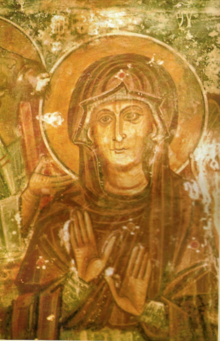Ioannis Pagomenos | |
|---|---|
 Virgin Mary by Ioannis Pagomenos | |
| Born | c.1285 Candia, Crete (?) |
| Died | after 1340 Crete (?) |
| Nationality | Greek |
| Style | Byzantine |
Ioannis Pagomenos (Greek: Ιωάννης Παγωμένος, c.1285[1]–after 1340) was a Greek painter in the Byzantine style active in Venetian-ruled Crete. He created fresco cycles for rural Orthodox churches under commission from ordinary members of the local peasant communities, who acted as collective patrons. While he could be considered a forerunner to the Cretan School, which saw success in producing hybrid-style icons for an international clientele, his work was more traditional in character and only incorporated Western influences in secondary details, as it catered to regional tastes.[2][3] His style nonetheless shows significant development over the years.[4] His frescos survive in four districts of the Chania prefecture, with the majority in the mountainous province of Selino, which displays the highest density of church painting in Crete.[5] His art influenced Andreas Pavias, Angelos Akotantos, Andreas Ritzos, and Nikolaos Tzafouris.[citation needed] By 1337/8 Pagomenos was working together with his son Nikolaos within the framework of a small family workshop of painters, other examples of which are known from contemporary Crete and the Aegean.[6][7][8]
Pagomenos was most likely born in Candia where his surname is well attested, in contrast to Selino. He is also supposed to have trained there as an artist, due to the weakness of Chania as an urban centre at the time.[9] The early fourteenth-century Cretan painters Theodoros Daniil and his nephew Michail Veneris, also active in western Crete, might have exerted a formative influence on Pagomenos before he developed his own distinctive style.[10][11][12] His contemporaries elsewhere in the Byzantine Empire included Manuel Panselinos, Michael Astrapas and Eutychios from Macedonia. The only record of Pagomenos' life is in the churches he signed. His career in western Crete spanned nearly three decades from 1313/4 to 1340, and his workshop continued to operate into the 1360s under the new stylistic direction of his son Nikolaos.[13][14]
The painter's own name has been deciphered in nine dedicatory inscriptions to date, with a tenth mention being traced to Pagomenos through family context:[14][15][16]
In addition, the workshop of Pagomenos has been credited with the below dateable church paintings: